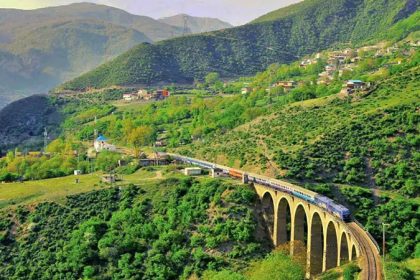The Alhambra Palace in Granada is one of the most visited historical monuments in the world, located in the beautiful region of Andalusia, Spain. This palace, with its extraordinary and stunning architecture, Generalif gardens and magnificent Nazarene palaces, tells a fascinating and audible story of Spain’s rich past. . The name of this palace with complex Islamic arts is seen among the registered heritage in UNESCO. Every year, hundreds of tourists from all over the world travel to Granada just to see Alhambra and its attractions. In this article, you will read more about the history, different parts and how to visit the Alhambra Palace in Spain.
Introducing the Alhambra Palace
Al-Hamra is a beautiful collection of buildings and gardens. Its tree-filled corridors along with water streams have created a pleasant and cool shade. This palace was once the largest political and aristocratic center of Muslims in the West. The grounds of the palace include beautiful rectangular courtyards, numerous fountains, as well as Nasrid buildings, which were the residences of the kings and their retinues. The oldest building in the complex is the Alcazaba citadel, and one of the most important structures is the Lavella Tower, which displays one of the most beautiful views of Alhambra. Another amazing part of Alhambra Palace in Spain is the courtyard of lions with its fountains. You can plan to visit the Alhambra Palace by booking a Spain tour.

History of Alhambra Palace in Spain
The history of Alhambra is directly related to the geographical location in which it is located, i.e. the city of Granada. On a rocky hill that is relatively difficult to access, on the banks of the Darro River, surrounded by mountains and forests, and right in the middle of the oldest neighborhoods of the city, the red Alhambra stands out like a magnificent castle and captivates the viewers.
Originally designed as a military area, Alhambra became the residence and royal court of Granada in the middle of the 13th century after the establishment of the Nasrid Kingdom and the construction of the first palace by King Muhammad bin Yusuf bin Nasr.
Star Vank special tours: Europe tour

Throughout the 13th, 14th, and 15th centuries, Spain’s Aljamera Palace became a fortress of high walls and defensive towers, the two main areas being the Military District or Alcazaba, the barracks of the Royal Guard, and the Medina or Palatine City, where the famous Nazarene palaces and the remains of noble houses and It housed the plebeians who lived there. The palace of Carlos V (built after the capture of the city in 1492 by the Catholic kings) is also located in the Medina.
The historic complex also has a free-standing palace in front of the Alhambra, surrounded by gardens, which was the resting place of the Grenadine kings called The Generalife.
The name Al-Hamra is derived from an Arabic word meaning “red or magenta castle”, perhaps because of the color of the towers and walls that completely surround La Sabica hill. Of course, the walls look almost golden in the sunlight.
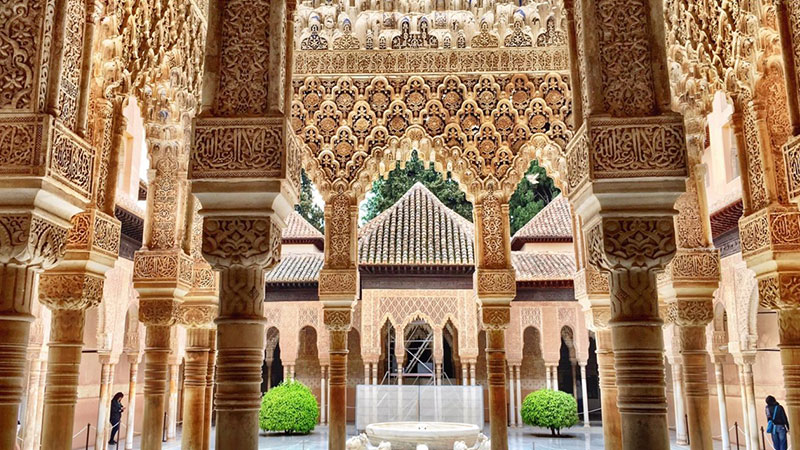
Originally created for military purposes, Alhambra was a fort, a palace and a small medina. Describing the palace to this triple character helps us to better understand the characteristics of this historic building.
Historical evidence does not mention Alhambra as a royal residence until the 13th century, although fortifications have existed since the 9th century. With the Muslim domination of Spain, Alhambra was built as a magnificent palace for Muslim princes on the ruins of a Roman building.
The founder of the dynasty, Muhammad Al-Ahmar, started the construction of the castle by rebuilding the old castle. His work was completed by his son Muhammad II, and subsequent successors continued to expand the castle. The construction of the palaces (called Casa Real Vieja) dates back to the 14th century and is the work of two great kings, Joseph I and Mohammed V. The first king added parts of the fourth sign, the door of justice, a bath and several towers to the collection, and his son Muhammad V completed the beautification of the palaces with the hall of lions, in addition to other rooms and fortifications.
To read more, read: A comprehensive guide to traveling to Spain
Finally, Spain’s Alhambra Palace became a Christian court in 1492 when the Catholic kings conquered Granada. Later, several buildings were added to the palace to accommodate prominent citizens, military barracks, a church and a Franciscan monastery.

Read more: 10 common mistakes in traveling to Spain and how to avoid them
Different parts of Alhamra Palace
The magnificent Alhambra Palace of Spain consists of different parts, each of which alone can dazzle the eyes of visitors. This section includes:
the court
The court is a part of the royal palace where the sultan takes care of the daily affairs of the country and the decorations of this part are very impressive.
Shabestan
Unlike the bargah, the part of the nave has very beautiful decorations and includes rooms and several green courtyards. This part of the palace was used to receive ambassadors.
Shiran’s water feature in Alhambra Palace, Spain
Shiran Waterfront is one of the most beautiful, popular and special parts of Alhambra Palace in Spain. This area was built in the second half of the 14th century during the reign of Muhammad V. Hall of Two Sisters, Hall of Abencerrajes and Hall of Kings together with Shiran area form the Harem Serai of the Royal Palace and have unique architectural details.
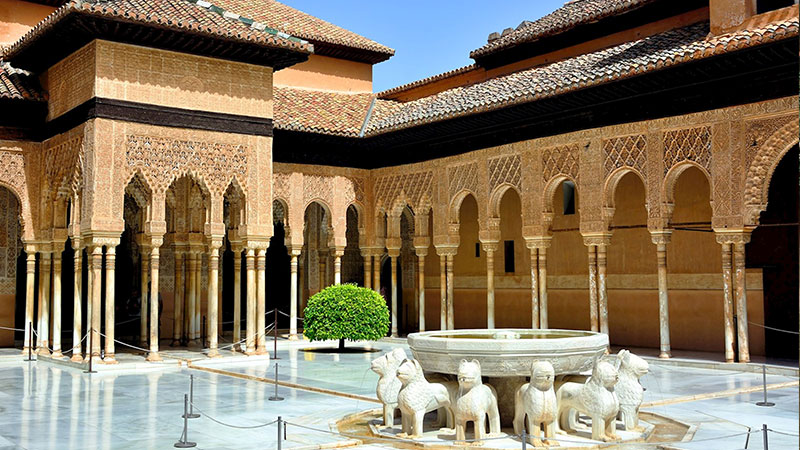
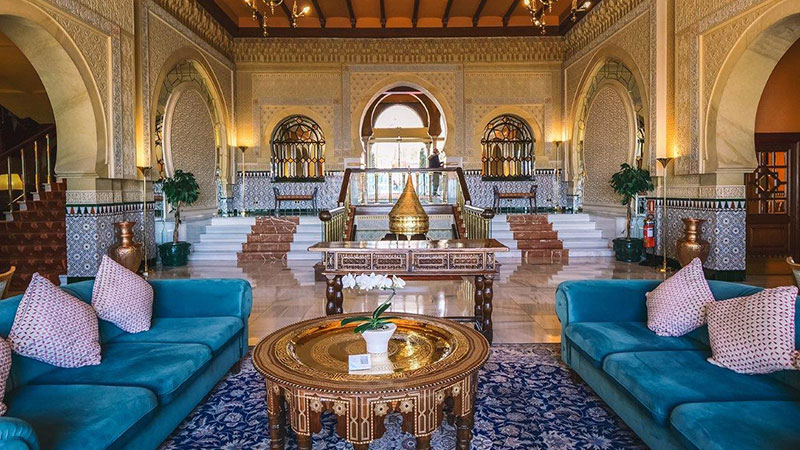

General information about Alhambra Palace
- The approximate duration of visiting Alhambra Palace in Spain is 2 hours and 30 minutes.
- Dominant local guides are present in the palace.
- If you request a tour with a private guide, English, Spanish and French speaking guides are available.
- Address: Real de la Alhambra, s/n, Centro, 18009 Granada, Spain
- Visiting hours: all days of the week from 8:30 to 20:00
- Check the opening hours of the palace on Spanish national holidays.
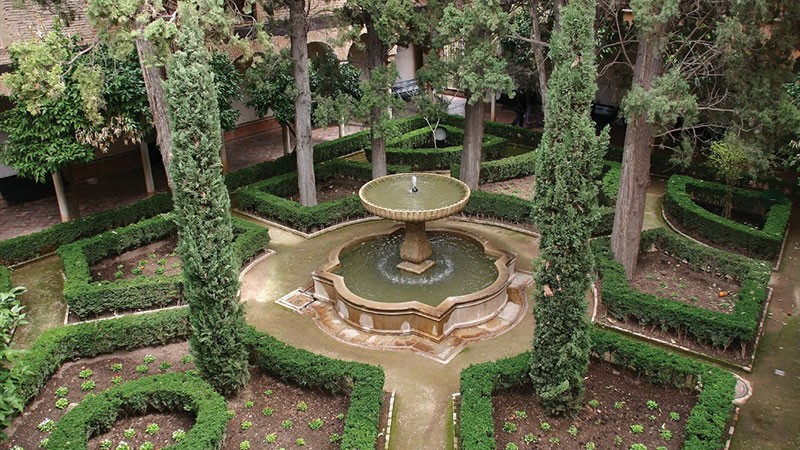
Read more: Introduction of Spanish festivals
How to buy Alhambra Palace tickets in Spain
You have several options to buy tickets for Alhambra Palace in Spain. For example, a public ticket allows access to all areas that are open to the public. But the gardens ticket only gives access to the main areas of the grounds. There are also two tickets for night visits: one for the palaces (available year-round) and one for the gardens and the Generalife Palace (available from April to November). The Al Hamra Experiences ticket includes an overnight tour of the Nasrid Palaces and a day tour of the gardens the following day. You can see the ticket prices and details below:
Ticket price for visiting Alcazaba, Nasrid Palaces, Partal, Generalife and Gardens
- Public visit includes all day visit areas of the garden
- Adult ticket price: €19.09
- Ticket price for minors between 12 and 15 years old: 12.73 euros
- Children under 12 years old: free entry
- EU citizens 65 years and older: €12.73
- EU citizens with European Youth Card: €12.73
- Persons with disabilities (equal to or greater than 33%): €12.73
- Members of large families: €12.73
Ticket prices for Gardens, Generalife and Alcazaba in Spain’s Alhambra Palace
Visitors can access the following spaces:
Promenade of Cypress Trees, Dry Land, San Francisco Gardens.
Alcazaba: Candle Tower and Adaros Garden.
Partal: palace portico, gardens and walks.
Generalife: Palace and Garden (Main Canal Court, Sultana Court and Blue Stairs)
This ticket does not provide access to Nasrid palaces.
Ticket price
- Adults: €10.61
- Minors between 12 and 15 years old: 7.42 euros
- Children under 12 years old: free entry
- EU citizens 65 years and older: €7.42
- EU citizens with European Youth Card: €7.42
- Persons with disabilities (equal to or greater than 33%): €7.42
- Members of large families: €7.42
Night visit to Nasrid palaces
This ticket allows you to visit the Nasrid Palaces, the Palace of Carlos V and the Gate of Justice in the Alhambra Palace of Spain.
This ticket includes:
Access to Generalife Palace at night.
Visiting the historical monument during the day.
Ticket price
- Adults: €10.61
- Minors between 12 and 15 years old: 7.42 euros
- Children under 12 years old: free entry
- EU citizens 65 years and older: €7.42
- EU citizens with European Youth Card: €7.42
- Persons with disabilities (equal to or greater than 33%): €7.42
- Members of large families: €7.42
Night visit to the gardens and general life at Alhambra Palace in Spain
This ticket allows you to visit Generalife Gardens and Generalife Palace by walking among the walnut trees of Generalife.
This ticket includes:
Access to Nazarene palaces at night.
Visiting the historical monument during the day.
Ticket price
- Adults: €7.42
- Minors between 12 and 15 years old: 5.30 euros
- Children under 12 years old: free entry
- EU citizens 65 years and older: 5.30 euros
- EU citizens with the European Youth Card: €5.30
- People with disabilities (equal to or above 33%): 5.30 euros
- Members of large families: 5.30 euros

Pay attention to the following points to visit the Alhambra Palace in Spain
- Pay attention when traveling with children under 12 years old: the ticket for these children is free, but you must reserve the ticket for them. In the case of minors between 3 and 11 years of age, the ticket must be reserved together with other adults at the time of purchase. Tickets for children under 3 years old are free and no need to book in advance as they are offered at ticket offices or at the entrance of the building.
- To visit, keep the following distances in mind: it takes 15 minutes from the entrance of the Alhambra to the Generalif, 17 minutes to the Nasrid Palaces, and 20 minutes to the Alcazaba.
- Take your digital or printed tickets with you.
- To gain access, you must show your physical or digital QR code ticket in addition to providing your ID or passport. If you wish, you can receive the ticket printed on A4 paper or with the type of ticket that is offered at ticket counters and automatic machines.
- Due to the high demand for tickets and the limited number of visitors, advance booking is recommended.
- Due to the limited capacity, you can access the Nasrid Palaces only at the time specified in your ticket. If you do not visit them within this time frame, you will lose your right to visit this part of Alhambra. If your time for the Nasrid Palaces coincides with the final entrance of the day (an hour before closing time), it is recommended to visit the Generalife and the Alcazaba before entering the Nasrid Palaces, which will take at least half an hour.

Interesting facts about Alhambra Palace
- Al-Hamra means red in Arabic, the name of the castle is also derived from its red towers and walls.
- Alhambra Castle was built on Roman ruins after the Muslim conquest of Spain.
- In the past, each of the residents of the castle had special passageways according to their social class and status. For example, the corridors for staff, crew and Latan and his family were separate from each other.
- Al-Hamra was known as a separate city with 6 palaces, numerous baths, two towers and an irrigation system called “acequias”.
- Most of the walls of Al-Hamra are decorated with quotes from the Quran.
- At the height of its power, Alhambra Palace was so beautiful that it was called heaven on earth.
- Al-Hamra tiles are pure symmetry and all corners adhere to mathematical principles.
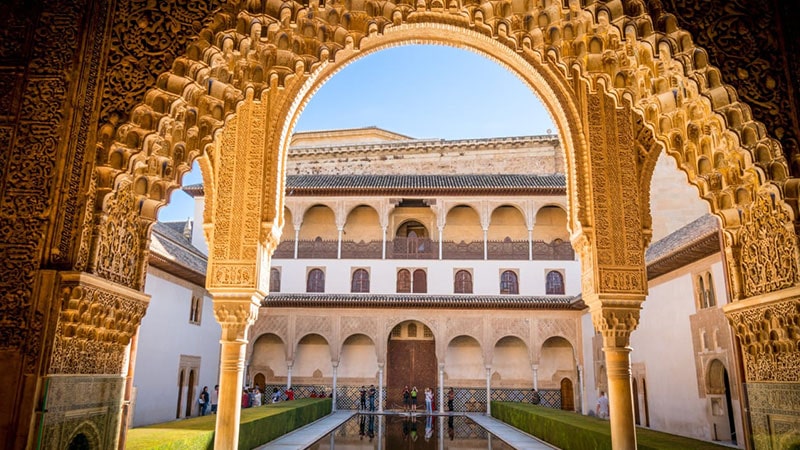
final word
Spain’s Alhambra Palace can be considered a valuable relic of the period of Muslim rule over Spain. Although this domination ended with the victory of the Catholics, the influence of Arab culture and architecture can still be seen in the food, architecture of buildings, and even the handicrafts of Spain. The Alhambra Palace is also known as one of the most famous and popular tourist attractions in Spain with stunning decorations of Islamic architecture. To visit the Alhambra Palace, book a tour of Spain and get a Schengen tourist visa, contact our colleagues in the foreign tours department.
Copying of the contents of Setare Vanak Airline Agency is prohibited only by mentioning the source.
RCO NEWS
















